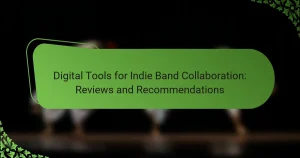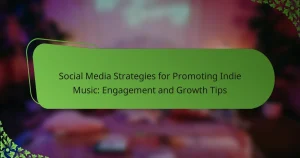Online platforms for indie music distribution offer increased visibility and higher royalty retention for artists. However, challenges like revenue sharing and technical complexity persist. Popular platforms such as DistroKid, TuneCore, and CD Baby cater to different needs and budgets. Regional preferences and key features like pricing, reach, and ease of use further influence platform selection.
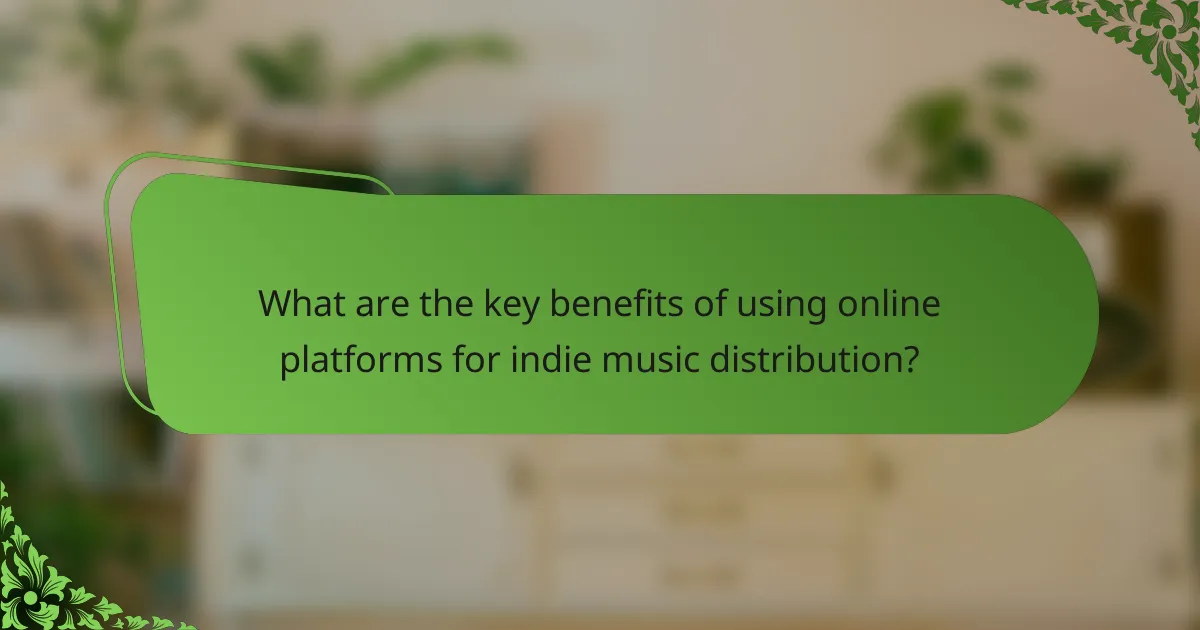
What are the key benefits of using online platforms for indie music distribution?
Using online platforms for indie music distribution offers several key benefits. These platforms enhance visibility, provide access to global audiences, and streamline the distribution process.
They allow artists to retain a higher percentage of royalties compared to traditional methods. Online platforms often provide valuable analytics, helping artists understand listener demographics and engagement. Additionally, many platforms offer tools for marketing and promotion, enabling indie artists to build their brand effectively.
Overall, these benefits empower independent musicians to thrive in a competitive industry.
How do these platforms enhance artist visibility and reach?
Online platforms enhance artist visibility and reach by providing global access and targeted marketing tools. They allow indie musicians to distribute their music widely, connect with fans directly, and utilize analytics for informed promotional strategies. Platforms like Spotify and Bandcamp facilitate playlist placements and social sharing, increasing exposure. Additionally, user-generated content and collaborations on these platforms can amplify an artist’s presence in niche markets.
What financial advantages do indie artists gain through digital distribution?
Indie artists gain significant financial advantages through digital distribution, including higher revenue shares and wider audience reach. Digital platforms typically offer better profit margins compared to traditional methods. For instance, artists can retain up to 85% of their earnings on certain platforms. Additionally, low distribution costs allow for more frequent releases, increasing potential income. The ability to directly engage with fans through social media and streaming services further enhances monetization opportunities.
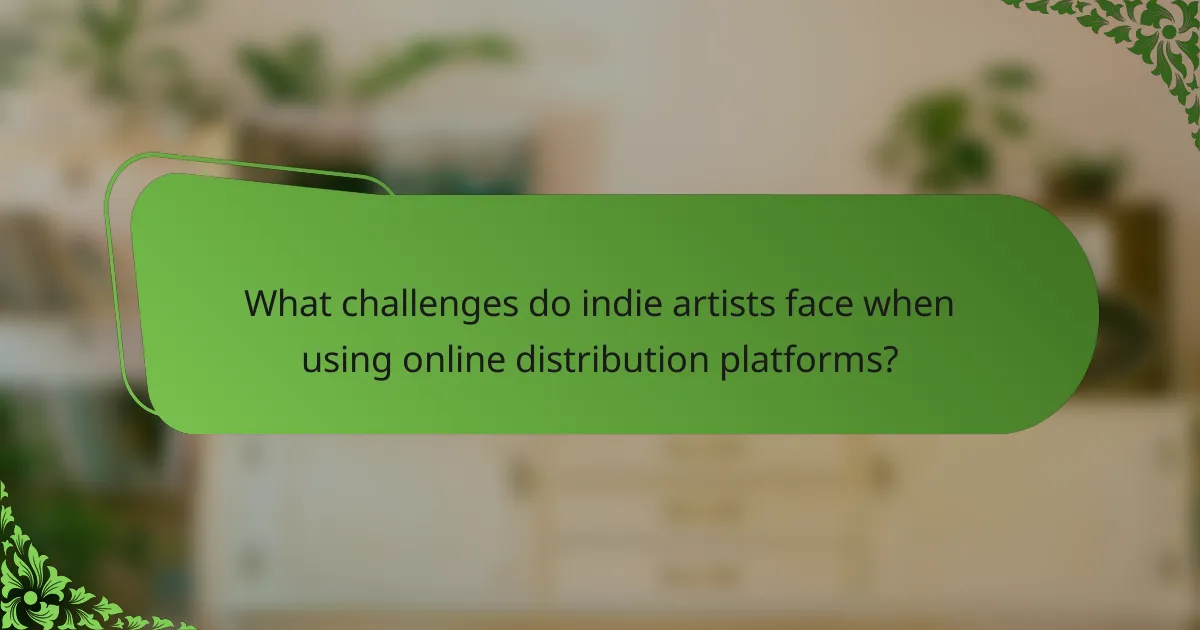
What challenges do indie artists face when using online distribution platforms?
Indie artists face several challenges with online distribution platforms, including visibility, revenue sharing, and technical complexity. Many platforms have extensive catalogs, making it hard for new artists to stand out. Revenue models often favor established artists, leading to lower earnings for indie creators. Additionally, the technical aspects of uploading and managing music can be daunting for those without experience. These factors can hinder an indie artist’s ability to effectively reach their audience and monetize their work.
Which common pitfalls should artists be aware of when selecting a platform?
Artists should be aware of several common pitfalls when selecting an online platform for music distribution. One major issue is the lack of transparency in fees, which can reduce earnings without clear justification. Additionally, platforms may impose restrictive terms that limit creative control or ownership of music. Another concern is inadequate customer support, which can hinder artists when they face issues. Lastly, some platforms may not provide adequate marketing tools, making it difficult for artists to reach their audience effectively.
How do platform fees impact an indie artist’s earnings?
Platform fees significantly reduce an indie artist’s earnings by taking a percentage of sales and streaming revenue. These fees typically range from 15% to 30%, depending on the platform. For example, a platform charging 20% on a $1 track sale results in only $0.80 for the artist. Additionally, many platforms have tiered pricing models that may further impact earnings based on the volume of sales or streams. Understanding these fees is crucial for artists to maximize their income and select the best distribution options.
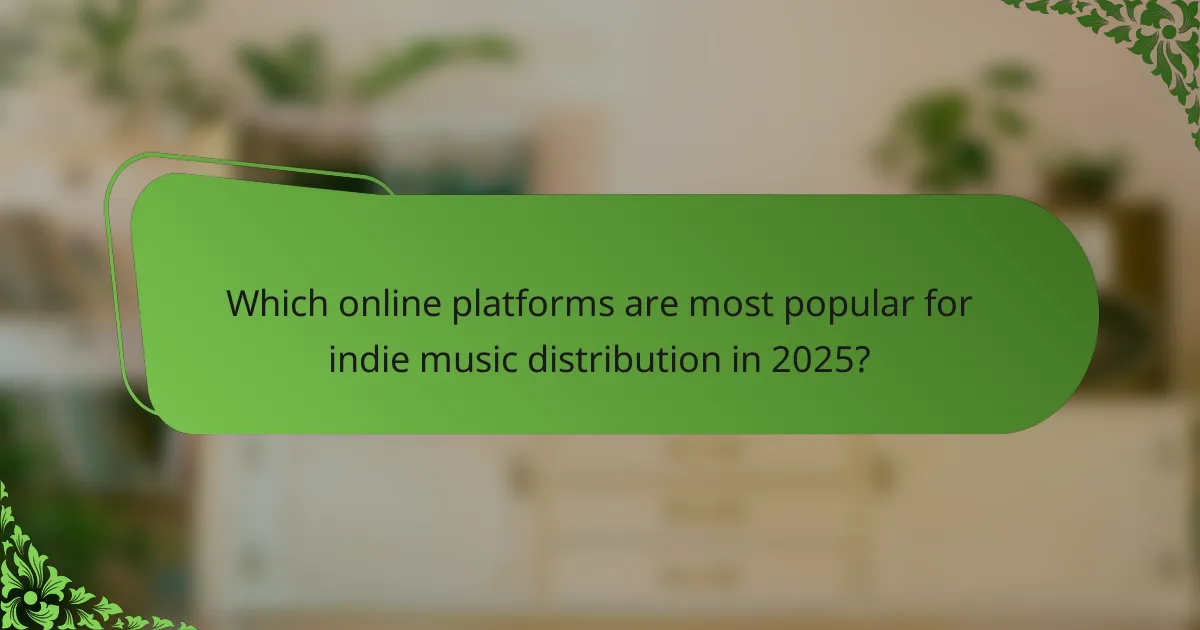
Which online platforms are most popular for indie music distribution in 2025?
In 2025, popular online platforms for indie music distribution include DistroKid, TuneCore, and CD Baby. These platforms offer unique benefits tailored to independent artists.
DistroKid provides unlimited uploads for a flat annual fee, making it cost-effective for prolific musicians. TuneCore offers a pay-per-release model, ideal for artists releasing fewer tracks. CD Baby combines distribution with physical sales options, appealing to artists with diverse merchandise strategies.
Each platform has unique attributes. DistroKid is known for speed, TuneCore for its comprehensive analytics, and CD Baby for artist support services. Artists should consider their distribution needs and budget when choosing a platform.
How does Bandcamp compare to DistroKid in terms of features and user experience?
Bandcamp offers more artist control and fan engagement, while DistroKid focuses on broad distribution and speed. Bandcamp allows direct sales and merchandise integration, enhancing user experience for indie artists. DistroKid provides streamlined uploads and faster release times, appealing to those prioritizing efficiency.
| Feature | Bandcamp | DistroKid |
|———————–|——————————-|——————————-|
| Artist Control | High | Moderate |
| Fan Engagement | Direct sales, messaging | Limited |
| Distribution Speed | Slower | Fast |
| Merchandise Options | Yes | No |
| Upload Process | Manual | Automated |
| Revenue Model | Percentage of sales | Annual fee |
What unique offerings do platforms like TuneCore provide for indie musicians?
TuneCore offers unique services for indie musicians, including global distribution, revenue tracking, and music publishing. These features empower artists to retain full control over their music while maximizing earnings. Additionally, TuneCore provides tools for marketing and promotion, helping musicians reach wider audiences effectively.
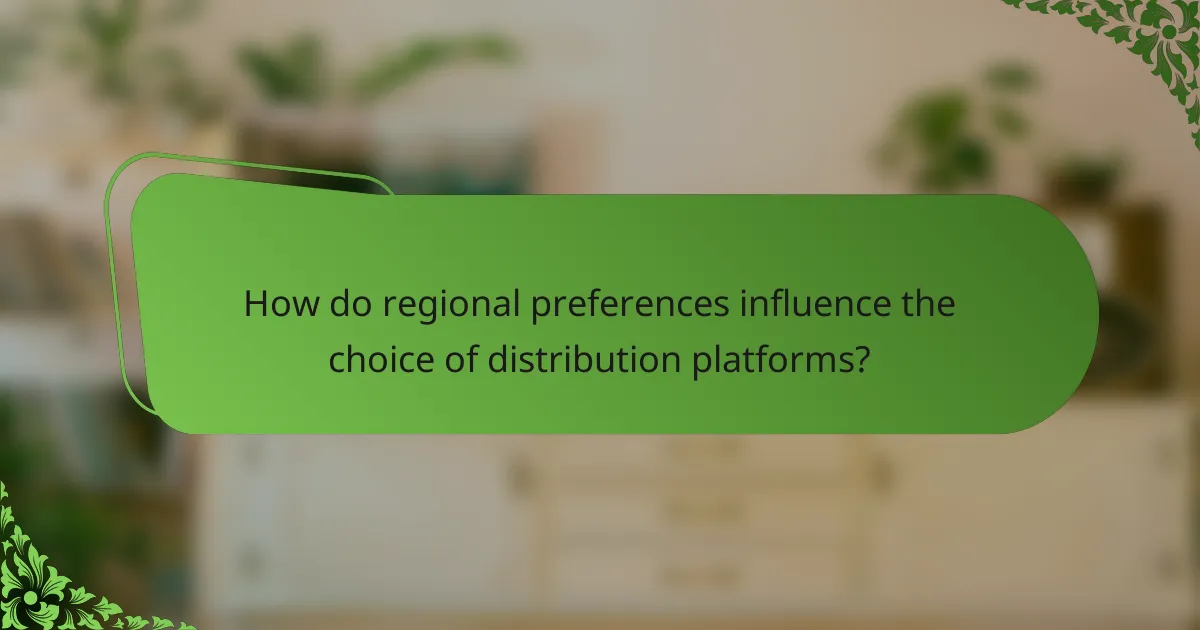
How do regional preferences influence the choice of distribution platforms?
Regional preferences significantly influence the choice of distribution platforms for indie music. Factors such as local music trends, cultural tastes, and language impact platform selection. For instance, artists in Europe may favor platforms like Bandcamp for niche audiences, while those in North America might prefer Spotify for broader reach. Additionally, regional licensing laws can limit platform availability, affecting distribution decisions. Understanding these preferences helps indie artists effectively target their audience and maximize their reach.
What factors drive platform popularity among artists in different regions?
Platform popularity among artists varies by region due to cultural preferences, market access, and local trends. In North America, platforms like Spotify dominate due to extensive user bases and promotional tools. In Europe, SoundCloud is favored for its community-driven approach, while in Asia, platforms like Tencent Music excel due to localized content and partnerships. Additionally, regional regulations and payment models impact artist engagement on these platforms.
Which platforms cater specifically to niche genres or local markets?
Several platforms cater specifically to niche genres or local markets in indie music distribution. Bandcamp focuses on independent artists, allowing direct sales and fan engagement. SoundCloud offers a community-driven space for emerging artists to showcase their work. DistroKid provides distribution to various streaming services, including niche platforms. ReverbNation supports local musicians with tools for promotion and fan management. These platforms enhance visibility and accessibility for indie artists in specific genres or regions.
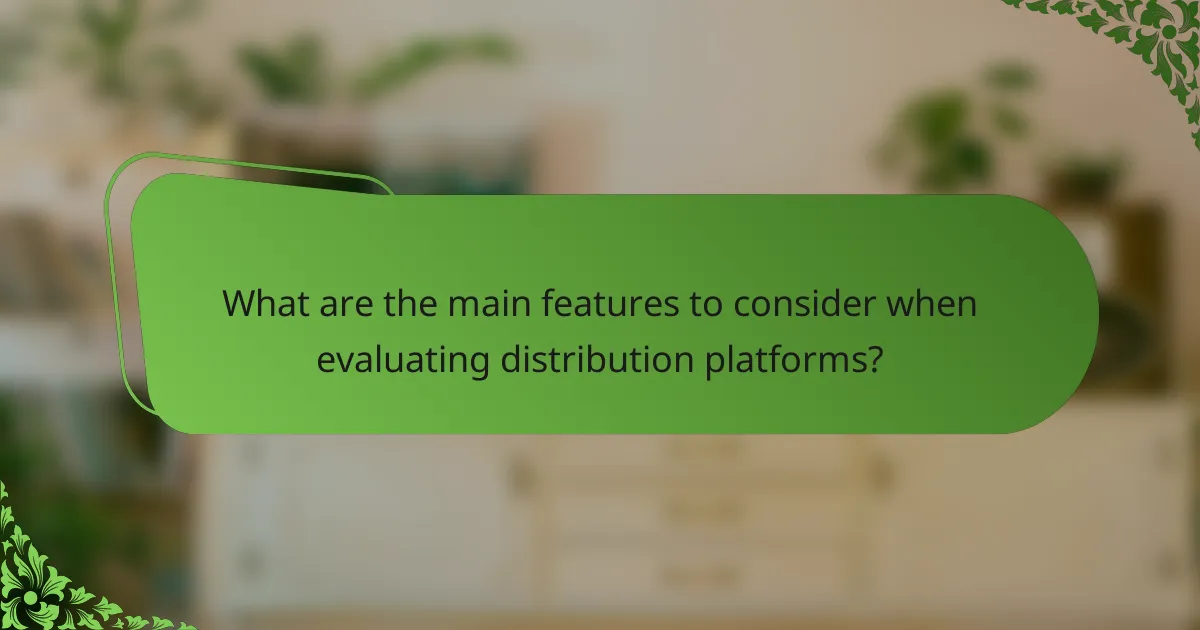
What are the main features to consider when evaluating distribution platforms?
When evaluating distribution platforms for indie music, consider features like pricing, reach, ease of use, and reporting tools. These attributes significantly influence your distribution strategy and artist visibility.
Pricing structures vary; some platforms charge upfront fees, while others take a percentage of sales. Reach is crucial; assess how many stores and streaming services the platform connects to. Ease of use impacts your workflow; a user-friendly interface saves time. Reporting tools provide insights into sales and audience engagement, essential for informed decision-making.
In summary, prioritize pricing, reach, ease of use, and reporting tools to select the best distribution platform for your indie music.
How important is customer support in the selection process?
Customer support is crucial in the selection process of online platforms for indie music distribution. It significantly influences user experience and satisfaction. Responsive and knowledgeable support can help artists navigate technical issues, understand platform features, and resolve disputes. Research shows that 70% of consumers consider customer support a key factor in platform loyalty. Additionally, platforms with robust support systems often receive higher ratings and attract more users. Thus, effective customer support can differentiate platforms in a competitive market.
Which analytics tools are essential for tracking music performance?
Essential analytics tools for tracking music performance include platforms like Spotify for Artists, Apple Music for Artists, and SoundCloud Analytics. These tools provide insights into listener demographics, streaming numbers, and engagement metrics. Each platform offers unique features, such as real-time data tracking and revenue analysis, essential for indie artists. For example, Spotify for Artists allows artists to understand their audience better and optimize their promotional strategies.

What are the best practices for maximizing exposure on distribution platforms?
To maximize exposure on distribution platforms, focus on strategic marketing and audience engagement. Utilize social media to promote releases, collaborate with influencers, and create visually appealing content. Optimize music metadata for searchability and consider leveraging playlists for wider reach. Engage with fans through live performances and interactive content to build a loyal following.
How can indie artists leverage social media alongside their distribution efforts?
Indie artists can effectively leverage social media by promoting their music and engaging with fans while utilizing distribution services. Social media platforms provide direct access to audiences, enabling artists to share updates and connect with listeners.
For example, artists can use Instagram and TikTok for visual storytelling, showcasing their music and behind-the-scenes content. Facebook groups and Twitter allow for community building and direct communication, enhancing fan loyalty.
Additionally, artists should align social media campaigns with distribution efforts, such as releasing singles and creating buzz around album launches. This integrated approach maximizes visibility and drives traffic to streaming platforms.
Overall, combining social media engagement with strategic distribution boosts an indie artist’s reach and potential for success.
What strategies can enhance playlist placements and streaming numbers?
To enhance playlist placements and streaming numbers, focus on targeted marketing, engaging social media, and networking with curators. Building relationships with playlist curators increases visibility. Utilize data analytics to identify trends and optimize release timing. Collaborate with other artists to reach wider audiences.
What common mistakes should indie artists avoid during the distribution process?
Indie artists should avoid common mistakes such as neglecting platform terms, failing to optimize metadata, and overlooking marketing strategies. These errors can hinder distribution success.
1. Ignoring platform terms and conditions can lead to unexpected fees or content removal.
2. Not optimizing metadata, including song titles and genre tags, limits discoverability.
3. Overlooking marketing strategies reduces audience engagement and sales potential.
4. Failing to understand the differences between platforms can result in poor distribution choices.
5. Not monitoring analytics prevents artists from making informed decisions about their music.
